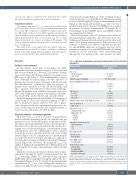Page 225 - 2021_06-Haematologica-web
P. 225
Subcutaneous daratumumab for RRMM: PAVO part 2
of each cycle. Disease evaluations were performed by a central laboratory until disease progression or end of treatment.
Statistical analyses
The primary endpoint of Ctrough at the end of weekly dosing (prior to the day 1 dose of cycle 3) was evaluated in patients who received all eight weekly doses of DARA SC and provided a pre- dose PK sample on day 1 of cycle 3 (PK-evaluable population). All other PK analyses were performed on the PK-analysis population, which included patients who received at least one dose of study drug and provided one or more post-infusion PK samples. The safety population included all patients who received at least one dose of study drug.
The study protocol was approved by the clinical study sites’ institutional review boards or ethics committees. Additional details on the study design, statistical analyses, and study supervi- sion are provided in the Online Supplementary Appendix.
Results
Patients and treatment
At the clinical cutoff date of December 14, 2018, 25 patients had been enrolled in part 2 of the study and had received DARA SC 1,800 mg. The patients’ median age was 68 (range, 51-85) years, and 24% of patients were ≥75 years of age (Table 1). The median number of prior lines of therapy was three (range, 2-9); 96% and 92% of patients had received prior treatment with bortezomib and lenalidomide, respectively. Fifty-six percent of patients were refractory to both a PI and an IMiD, and 76% of patients were refractory to the last line of therapy. Of the 16 patients with available cytogenetic data, four (25%) had a high-risk cytogenetic abnormality at baseline: two had del17p, one had t(4;14), and one had t(14;16).
Of the 25 patients treated with DARA SC during part 2 of the study, 19 (76%) discontinued treatment: 17 (68%) due to progressive disease and two (8%) due to physi- cians’ decision (both had unconfirmed progressive dis- ease). At the clinical cutoff date, the median duration of follow-up was 14.2 (range, 2.4-18.5) months.
Pharmacokinetics and immunogenicity
PK results for Ctrough on day 1 of cycle 3 are presented for the PK-evaluable population (n=22); all other PK data are presented based on the PK-analysis population (n=25). The linear mean daratumumab serum concentration pro- files after cycle 1 (first dose) and after the last weekly dose (eighth dose) are shown in Figure 1. Daratumumab serum concentrations after SC administration were sustained from 48 h post-dose onwards until the end of the dosing interval (Figure 1A). SC administration of daratumumab was followed by slow systemic absorption as opposed to the immediate systemic availability following IV adminis- tration (Figure 1A). However, the maximum Ctrough was similar or higher following DARA SC 1,800 mg than after the 16 mg/kg IV dosing of daratumumab (Figure 1B and Table 2).
Simulation of mean concentration-time profiles of dara- tumumab following SC and IV dosing revealed that the Ctrough following DARA SC 1,800 mg dosing remained higher than after 16 mg/kg IV dosing throughout the dos- ing regimen (Figure 2). For SC dosing, the mean maximum concentration (C ) was lower during early weekly dos-
every-2-week dosing (Figure 2). After reaching every-4- week dosing, the Cmax for DARA SC 1,800 mg was similar to that for the 16 mg/kg IV dosing of daratumumab overall (Figure 2). The mean and median Ctrough values for end of weekly dosing (day 1 of cycle 3) in PAVO part 2, as well as in patients receiving daratumumab 16 mg/kg IV as monotherapy in the GEN501 part 2 and SIRIUS studies, are summarized in Table 2.
Of the 25 patients, one (4%) patient was positive for anti-daratumumab antibodies; the antibodies were neu- tralizing and transient (detected only at week 4 after treat- ment). This patient experienced no IRR and had a best response of stable disease. One (4%) patient was positive for anti-rHuPH20 antibodies at baseline, and four (16%) patients were positive for anti-rHuPH20 antibodies during treatment; all the antibodies were non-neutralizing. Among the four patients who were positive for anti-
Table 1. Baseline demographics and clinical characteristics of the all-treated population.
Characteristic
Age, years Median (range) ≥75, n (%)
Median (range) weight, kg
Baseline ECOG Performance Status, n (%) 0
1 2
ISS stage, na I, n (%) II, n (%)
III, n (%)
Median (range) time from diagnosis, years
Type of myeloma, n
IgG, n (%)
Cytogenetic risk, nb Standard risk, n (%) High risk, n (%)
t(4;14) t(14;16) del17p
Prior lines of therapy, n (%) Median (range)
≤3
>3
Prior ASCT, n (%)
Prior PI, n (%)
Bortezomib
Prior IMiD, n (%) Lenalidomide
Refractory to, n (%) Bortezomib Lenalidomide
Both PI and IMiD Last line of therapy
DARA SC 1,800 mg (n=25)
68 (51-85) 6 (24.0)
70.9 (52.0-104.8)
11 (44.0) 13 (52.0) 1 (4.0)
24
13 (54.2) 5 (20.8) 6 (25.0)
5.9 (2.1-12.8)
24
13 (54.2)
16
12 (75.0) 4 (25.0)c 1 (6.3) 1 (6.3) 2 (12.5)
3 (2-9) 17 (68.0) 8 (32.0)
17 (68.0)
25 (100)
24 (96.0)
25 (100) 23 (92.0)
16 (64.0) 14 (56.0) 14 (56.0) 19 (76.0)
max
ing but was higher at the end of weekly dosing and during
otyping. cConsists of two patients with del17p, one patient with t(4;14), and one patient with t(14;16).
DARA: daratumumab; SC: subcutaneous; ECOG: Eastern Cooperative Oncology Group; ISS:
International Staging System; ASCT: autologous stem cell transplantation; PI: proteasome
inhibitor; IMiD: immunomodulatory drug. aISS stage is derived based on the combination of
serum b -microglobulin and albumin. bAssessed by fluorescence in situ hybridization or kary- 2
haematologica | 2021; 106(6)
1727


